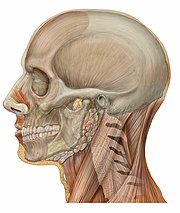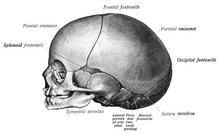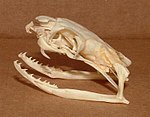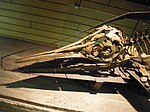Skull
| Skull | |
|---|---|
 Volume rendering of a mouse skull | |
| Details | |
| System | Skeletal system |
| Identifiers | |
| MeSH | D012886 |
| FMA | 54964 |
| Anatomical terminology | |
The skull is a bony structure that forms of the head in most vertebrates. It supports the structures of the face and provides a protective cavity for the brain.[1] The skull is composed of two parts: the cranium and the mandible. In the human these two parts are the neurocranium and the viscerocranium or facial skeleton that includes the mandible as its largest bone. The skull forms the anterior most portion of the skeleton and is a product of cephalisation—housing the brain, and several sensory structures such as the eyes, ears, nose, and mouth.[2] In humans these sensory structures are part of the facial skeleton.
Functions of the skull include protection of the brain, fixing the distance between the eyes to allow stereoscopic vision, and fixing the position of the ears to enable sound localisation of the direction and distance of sounds. In some animals such as horned ungulates, the skull also has a defensive function by providing the mount (on the frontal bone) for the horns.
The English word "skull" is probably derived from Old Norse "skulle", while the Latin word cranium comes from the Greek root κρανίον (kranion).
The skull is made up of a number of fused flat bones, and contains many foramina and processes, and several cavities or sinuses. In zoology there are openings in the skull called fenestrae.
Structure
- For details and the constituent bones, see neurocranium and viscerocranium.




The human skull is the bony structure that forms the head in the human skeleton. It supports the structures of the face and forms a cavity for the brain. Like the skulls of other vertebrates, it protects the brain from injury.
The skull consists of two parts, of different embryological origin—the neurocranium and the facial skeleton (also called the viscerocranium). The neurocranium (or braincase) forms the protective cranial cavity that surrounds and houses the brain and brainstem. The facial skeleton is formed by the bones supporting the face. The neurocranium includes the mandible.
Bones
Except for the mandible, all of the bones of the skull are joined together by sutures—synarthrodial (immovable) joints formed by bony ossification, with Sharpey's fibres permitting some flexibility. Sometimes there can be extra bone pieces within the suture known as wormian bones or sutural bones.
The human skull is generally considered to consist of twenty-two bones—eight cranial bones and fourteen facial skeleton bones. In the neurocranium these are the occipital bone, two temporal bones, two parietal bones, the sphenoid, ethmoid and frontal bones.
The bones of the facial skeleton are the vomer, two nasal conchae, two nasal bones, two maxilla, the mandible, two palatine bones, two zygomatic bones, and two lacrimal bones. Some sources count a paired bone as one, or the maxilla as having two bones (as its parts); some sources include the hyoid bone or the three ossicles of the middle ear but the overall general consensus of the number of bones in the human skull is the stated twenty-two.
Some of these bones—the occipital, parietal, frontal, in the neurocranium, and the nasal, lacrimal, and vomer, in the facial skeleton are flat bones.
Cavities and foramina

The skull also contains sinus cavities and numerous foramina. The sinuses are lined with respiratory epithelium. Their known functions are the lessening of the weight of the skull, the aiding of resonance to the voice and the warming and moistening of the air drawn through the nasal cavity.
The foramina are openings in the skull. The largest of these is the foramen magnum that allows the passage of the spinal cord as well as nerves and blood vessels.
Processes
The many processes of the skull include the mastoid process and the zygomatic process.
Development

The skull is a complex structure; its bones are formed both by intramembranous and endochondral ossification. The skull roof bones, comprising the bones of the facial skeleton and the sides and roof of the neurocranium, are dermal bones formed by intramembranous ossification, though the temporal bones are formed by endochondral ossification. The endocranium, the bones supporting the brain (the occipital, sphenoid, and ethmoid) are largely formed by endochondral ossification. Thus frontal and parietal bones are purely membranous.[3] The geometry of the skull base and its fossas: anterior, middle and posterior changes rapidly. The anterior cranial fossa changes especially during the first trimester of pregnancy and skull defects can often develop during this time.[4]
At birth, the human skull is made up of 44 separate bony elements. During development, many of these bony elements gradually fuse together into solid bone (for example, the frontal bone). The bones of the roof of the skull are initially separated by regions of dense connective tissue called fontanelles. There are six fontanelles: one anterior (or frontal), one posterior (or occipital), two sphenoid (or anterolateral), and two mastoid (or posterolateral). At birth these regions are fibrous and moveable, necessary for birth and later growth. This growth can put a large amount of tension on the "obstetrical hinge", which is where the squamous and lateral parts of the occipital bone meet. A possible complication of this tension is rupture of the great cerebral vein. As growth and ossification progress, the connective tissue of the fontanelles is invaded and replaced by bone creating sutures. The five sutures are the two squamous sutures, one coronal, one lambdoid, and one sagittal suture. The posterior fontanelle usually closes by eight weeks, but the anterior fontanel can remain open up to eighteen months. The anterior fontanelle is located at the junction of the frontal and parietal bones; it is a "soft spot" on a baby's forehead. Careful observation will show that you can count a baby's heart rate by observing the pulse pulsing softly through the anterior fontanelle.
The skull in the neonate is large in proportion to other parts of the body. The facial skeleton is one seventh of the size of the calvaria. (In the adult it is half the size). The base of the skull is short and narrow, though the inner ear is almost adult size.[5]
Clinical significance
Craniosynostosis is a condition in which one or more of the fibrous sutures in an infant skull prematurely fuses,[6] and changes the growth pattern of the skull.[7] Because the skull cannot expand perpendicular to the fused suture, it grows more in the parallel direction.[7] Sometimes the resulting growth pattern provides the necessary space for the growing brain, but results in an abnormal head shape and abnormal facial features.[7] In cases in which the compensation does not effectively provide enough space for the growing brain, craniosynostosis results in increased intracranial pressure leading possibly to visual impairment, sleeping impairment, eating difficulties, or an impairment of mental development.[8]
Injuries and treatment
Injuries to the brain can be life-threatening. Normally the skull protects the brain from damage through its hard unyieldingness; the skull is one of the least deformable structures found in nature with it needing the force of about 1 ton to reduce the diameter of the skull by 1 cm.[9] In some cases, however, of head injury, there can be raised intracranial pressure through mechanisms such as a subdural haematoma. In these cases the raised intracranial pressure can cause herniation of the brain out of the foramen magnum ("coning") because there is no space for the brain to expand; this can result in significant brain damage or death unless an urgent operation is performed to relieve the pressure. This is why patients with concussion must be watched extremely carefully.
Dating back to Neolithic times, a skull operation called trepanning was sometimes performed. This involved drilling a burr hole in the cranium. Examination of skulls from this period reveals that the patients sometimes survived for many years afterward. It seems likely that trepanning was also performed purely for ritualistic or religious reasons. Nowadays this procedure is still used but is normally called a craniectomy.
In March 2013, for the first time in the U.S., researchers replaced a large percentage of a patient's skull with a precision, 3D-printed polymer implant.[10] About 9 months later the first complete cranium replacement with a 3D-printed plastic insert was performed on a Dutch woman. She had been suffering from hyperostosis, which increased the thickness of her skull and compressed her brain.[11]
Transgender procedures
Surgical alteration of sexually dimorphic skull features may be carried out as a part of facial feminization surgery, a set of reconstructive surgical procedures that can alter male facial features to bring them closer in shape and size to typical female facial features.[12][13] These procedures can be an important part of the treatment of transgender people for gender dysphoria.[14][15]
Society and culture

Artificial cranial deformation is a largely historical practice of some cultures. Cords and wooden boards would be used to apply pressure to an infant's skull and alter its shape, sometimes quite significantly. This procedure would begin just after birth and would be carried on for several years.
Osteology
Like the face, the skull and teeth can also indicate a person's life history and origin. Forensic scientists and archaeologists use metric and nonmetric traits to estimate what the bearer of the skull looked like. When a significant amount of bones are found, such as at Spitalfields in the UK and Jōmon shell mounds in Japan, osteologists can use traits, such as the proportions of length, height and width, to know the relationships of the population of the study with other living or extinct populations.
The German physician Franz Joseph Gall in around 1800 formulated the theory of phrenology, which attempted to show that specific features of the skull are associated with certain personality traits or intellectual capabilities of its owner. His theory is now considered to be pseudoscientific.
Sexual dimorphism
In the mid-nineteenth century, anthropologists found it crucial to distinguish between male and female skulls. An anthropologist of the time, James McGrigor Allan, argued that the female brain was similar to that of an animal.[16] This allowed anthropologists to declare that women were in fact more emotional and less rational than men. McGrigor then concluded that women’s brains were more analogous to infants, thus deeming them inferior at the time.[17] To further these claims of female inferiority and silence the feminists of the time, other anthropologists joined in on the studies of the female skull. These cranial measurements are the basis of what is known as craniology. These cranial measurements were also used to draw a connection between women and black people.[17]
Research has shown that while in early life there is little difference between male and female skulls, in adulthood male skulls tend to be larger and more robust than female skulls, which are lighter and smaller, with a cranial capacity about 10 percent less than that of the male.[18] However, later studies show that women's skulls are slightly thicker and thus men may be more susceptible to head injury than women.[19][20]
Male skulls can have more prominent supraorbital ridges, a more prominent glabella, and more prominent temporal lines. Female skulls generally have rounder orbits, and narrower jaws. Male skulls on average have larger, broader palates, squarer orbits, larger mastoid processes, larger sinuses, and larger occipital condyles than those of females. Male mandibles typically have squarer chins and thicker, rougher muscle attachments than female mandibles.
Craniometry
The cephalic index is the ratio of the width of the head, multiplied by 100 and divided by its length (front to back). The index is also used to categorize animals, especially dogs and cats. The width is usually measured just below the parietal eminence, and the length from the glabella to the occipital point.
Humans may be:
- Dolichocephalic — long-headed
- Mesaticephalic — medium-headed
- Brachycephalic — short-headed
Other animals
Fish

The skull of fishes is formed from a series of only loosely connected bones. Lampreys and sharks only possess a cartilaginous endocranium, with both the upper and lower jaws being separate elements. Bony fishes have additional dermal bone, forming a more or less coherent skull roof in lungfish and holost fish. The lower jaw defines a chin.
The simpler structure is found in jawless fish, in which the cranium is normally represented by a trough-like basket of cartilaginous elements only partially enclosing the brain, and associated with the capsules for the inner ears and the single nostril. Distinctively, these fish have no jaws.[21]
Cartilaginous fish, such as sharks and rays, have also simple, and presumably primitive, skull structures. The cranium is a single structure forming a case around the brain, enclosing the lower surface and the sides, but always at least partially open at the top as a large fontanelle. The most anterior part of the cranium includes a forward plate of cartilage, the rostrum, and capsules to enclose the olfactory organs. Behind these are the orbits, and then an additional pair of capsules enclosing the structure of the inner ear. Finally, the skull tapers towards the rear, where the foramen magnum lies immediately above a single condyle, articulating with the first vertebra. There are, in addition, at various points throughout the cranium, smaller foramina for the cranial nerves. The jaws consist of separate hoops of cartilage, almost always distinct from the cranium proper.[21]

In ray-finned fishes, there has also been considerable modification from the primitive pattern. The roof of the skull is generally well formed, and although the exact relationship of its bones to those of tetrapods is unclear, they are usually given similar names for convenience. Other elements of the skull, however, may be reduced; there is little cheek region behind the enlarged orbits, and little, if any bone in between them. The upper jaw is often formed largely from the premaxilla, with the maxilla itself located further back, and an additional bone, the symplectic, linking the jaw to the rest of the cranium.[22]
Although the skulls of fossil lobe-finned fish resemble those of the early tetrapods, the same cannot be said of those of the living lungfishes. The skull roof is not fully formed, and consists of multiple, somewhat irregularly shaped bones with no direct relationship to those of tetrapods. The upper jaw is formed from the pterygoids and vomers alone, all of which bear teeth. Much of the skull is formed from cartilage, and its overall structure is reduced.[22]
Tetrapods


The skulls of the earliest tetrapods closely resembled those of their ancestors amongst the lobe-finned fishes. The skull roof is formed of a series of plate-like bones, including the maxilla, frontals, parietals, and lacrimals, among others. It is overlaying the endocranium, corresponding to the cartilaginous skull in sharks and rays. The various separate bones that compose the temporal bone of humans are also part of the skull roof series. A further plate composed of four pairs of bones forms the roof of the mouth; these include the vomer and palatine bones. The base of the cranium is formed from a ring of bones surrounding the foramen magnum and a median bone lying further forward; these are homologous with the occipital bone and parts of the sphenoid in mammals. Finally, the lower jaw is composed of multiple bones, only the most anterior of which (the dentary) is homologous with the mammalian mandible.[22]
In living tetrapods, a great many of the original bones have either disappeared or fused into one another in various arrangements.
Birds


Birds have a diapsid skull, as in reptiles, with a pre-lacrymal fossa (present in some reptiles). The skull has a single occipital condyle.[23] The skull consists of five major bones: the frontal (top of head), parietal (back of head), premaxillary and nasal (top beak), and the mandible (bottom beak). The skull of a normal bird usually weighs about 1% of the bird's total bodyweight. The eye occupies a considerable amount of the skull and is surrounded by a sclerotic eye-ring, a ring of tiny bones. This characteristic is also seen in reptiles.
Amphibians

Living amphibians typically have greatly reduced skulls, with many of the bones either absent or wholly or partly replaced by cartilage.[22] In mammals and birds, in particular, modifications of the skull occurred to allow for the expansion of the brain. The fusion between the various bones is especially notable in birds, in which the individual structures may be difficult to identify.
Structure
Fenestrae



|
The fenestrae (from Latin, meaning windows) are openings in the skull.
|
The temporal fenestrae are anatomical features of the skulls of several types of amniotes, characterised by bilaterally symmetrical holes (fenestrae) in the temporal bone. Depending on the lineage of a given animal, two, one, or no pairs of temporal fenestrae may be present, above or below the postorbital and squamosal bones. The upper temporal fenestrae are also known as the supratemporal fenestrae, and the lower temporal fenestrae are also known as the infratemporal fenestrae. The presence and morphology of the temporal fenestra are critical for taxonomic classification of the synapsids, of which mammals are part.
Physiological speculation associates it with a rise in metabolic rates and an increase in jaw musculature. The earlier amniotes of the Carboniferous did not have temporal fenestrae but two more advanced lines did: the synapsids (mammal-like reptiles) and the diapsids (most reptiles and later birds). As time progressed, diapsids' and synapsids' temporal fenestrae became more modified and larger to make stronger bites and more jaw muscles. Dinosaurs, which are diapsids, have large advanced openings, and their descendants, the birds, have temporal fenestrae which have been modified. Mammals, which are synapsids, possess no fenestral openings in the skull, as the trait has been modified. They do, though, still have the temporal orbit (which resembles an opening) and the temporal muscles. It is a hole in the head and is situated to the rear of the orbit behind the eye.
Classification


There are four types of amniote skull, classified by the number and location of their temporal fenestrae. These are:
- Anapsida – no openings
- Synapsida – one low opening (beneath the postorbital and squamosal bones)
- Euryapsida – one high opening (above the postorbital and squamosal bones); euryapsids actually evolved from a diapsid configuration, losing their lower temporal fenestra.
- Diapsida – two openings
Evolutionarily, they are related as follows:
- Amniota
- Class Synapsida
- Order Therapsida
- Class Mammalia – mammals
- Order Therapsida
- (Unranked) Sauropsida – reptiles
- Subclass Anapsida
- (unranked) Eureptilia
- Subclass Diapsida
- (unranked) Euryapsida
- Class Aves – birds
- Subclass Diapsida
- Class Synapsida
Bones
The jugal is a skull bone found in most reptiles, amphibians, and birds. In mammals, the jugal is often called the zygomatic bone or malar bone.
The prefrontal bone is a bone separating the lacrimal and frontal bones in many tetrapod skulls.
Terminology
- Chondrocranium, a primitive cartilagionous skeletal structure
- Endocranium
- Epicranium
- Pericranium, a membrane that lines the outer surface of the cranium
Additional images
- Mammals
-
An elephant skull in Serengeti National Park
-
A hippopotamus skull
-
Killer whale skull
-
German Shepherd
-
Poodle
-
Fox
-
Cat
-
Camel
- Birds
-
A vulture skull
-
Frontal view of Anatidae skull
-
Cranium and jaw of Anatidae
- Reptiles
-
King cobra skull
-
An ichthyosaur skull
See also
- Craniometry
- Crystal skull
- Head and neck anatomy
- Human skull symbolism
- Memento mori
- Plagiocephaly, the abnormal flattening of one side of the skull
- Skull and crossbones (disambiguation)
- Teshik-Tash
- Totenkopf
- Yorick
References
![]() This article incorporates text in the public domain from page 128 of the 20th edition of Gray's Anatomy (1918)
This article incorporates text in the public domain from page 128 of the 20th edition of Gray's Anatomy (1918)
- ^ "Merriam-Webster dictionary". Merriam-Webster.
- ^ "Cephalization: Biology". Encyclopædia Britannica. Retrieved 23 April 2016.
- ^ Carlson, Bruce M. (1999). Human Embryology & Developmental Biology. Mosby. pp. 166–170. ISBN 0-8151-1458-3.
- ^ Derkowski, Wojciech; Kędzia, Alicja; Glonek, Michał (2003). "Clinical anatomy of the human anterior cranial fossa during the prenatal period". Folia morphologica. 62 (3): 271–3. PMID 14507064.
- ^ a b Chaurasia. Human Anatomy Volume 3. CBS Publishers & Distributors Pvt Ltd. pp. 29–30. ISBN 978-81-239-2332-1.
- ^ Silva, Sandra; Philippe Jeanty (7 June 1999). "Cloverleaf skull or kleeblattschadel". TheFetus.net. MacroMedia. Retrieved 3 February 2007.
- ^ a b c Slater BJ, Lenton KA, Kwan MD, Gupta DM, Wan DC, Longaker MT (April 2008). "Cranial sutures: a brief review". Plast. Reconstr. Surg. 121 (4): 170e–8e. doi:10.1097/01.prs.0000304441.99483.97. PMID 18349596.
- ^ Gault DT, Renier D, Marchac D, Jones BM (September 1992). "Intracranial pressure and intracranial volume in children with craniosynostosis". Plast. Reconstr. Surg. 90 (3): 377–81. doi:10.1097/00006534-199209000-00003. PMID 1513883.
- ^ Holbourn, A. H. S. (1943). Mechanics of Head Injuries. The Lancet, 242: (6267), 438-441. doi:10.1016/S0140-6736(00)87453-X
- ^ "3D-Printed Polymer Skull Implant Used For First Time in US". Medicaldaily.com. 7 March 2013. Retrieved 24 September 2013.
- ^ "Dutch hospital gives patient new plastic skull, made by 3D printer". Dutchnews.nl. 26 March 2014.
- ^ Ainsworth, TA; Spiegel, JH (2010). "Quality of life of individuals with and without facial feminization surgery or gender reassignment surgery". Quality of life research : an international journal of quality of life aspects of treatment, care and rehabilitation. 19 (7): 1019–24. doi:10.1007/s11136-010-9668-7. PMID 20461468.
- ^ Shams, MG; Motamedi, MH (2009). "Case report: Feminizing the male face". Eplasty. 9: e2. PMC 2627308. PMID 19198644.
- ^ World Professional Association for Transgender Health. WPATH Clarification on Medical Necessity of Treatment, Sex Reassignment, and Insurance Coverage in the U.S.A. (2008).
- ^ World Professional Association for Transgender Health. Standards of Care for the Health of Transsexual, Transgender, and Gender Nonconforming People, Version 7. pg. 58 (2011).
- ^ Fee, Elizabeth (1979). Nineteenth-Century Craniology: The Study of the Female Skull. pp. 415–473.
- ^ a b Fee, Elizabeth (1979). Nineteenth-Century Craniology: The Study of the Female Skull. pp. 415–453.
- ^ "The Interior of the Skull". Gray's Anatomy. Retrieved 22 October 2014.
- ^ "Men May Be More Susceptible To Head Injury Than Women, Study Suggests". Science Daily. Retrieved 6 June 2012.
- ^ Li, Haiyan; Ruan, Jesse; Xie, Zhonghua; Wang, Hao; Liu, Wengling (2007). "Investigation of the critical geometric characteristics of living human skulls utilising medical image analysis techniques". International Journal of Vehicle Safety. 2 (4): 345–367. doi:10.1504/IJVS.2007.016747.
- ^ a b Romer, Alfred Sherwood; Parsons, Thomas S. (1977). The Vertebrate Body. Philadelphia, PA: Holt-Saunders International. pp. 173–177. ISBN 0-03-910284-X.
- ^ a b c d Romer, Alfred Sherwood; Parsons, Thomas S. (1977). The Vertebrate Body. Philadelphia, PA: Holt-Saunders International. pp. 216–247. ISBN 0-03-910284-X.
- ^ Wing, Leonard W. (1956) Natural History of Birds. The Ronald Press Company.
External links
- Dept of Anth Skull Module
- Skull Anatomy Tutorial.
- Bird Skull Collection Bird skull database with very large collection of skulls (Agricultural University of Wageningen)
- Human skull base with very detailed labelling in German
- Human Skulls / Anthropological Skulls / Comparison of Skulls of Vertebrates (PDF; 502 kB)













